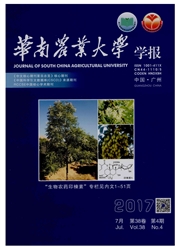

 中文摘要:
中文摘要:
摘要纤维素结合蛋白(cellulose binding protein,CBP)是植物寄生线虫在侵染过程中分泌的重要效应蛋白。为了获得象耳豆根结线虫(Meloidogyne enterolobii)纤维素结合蛋白序列信息、并分析其在线虫寄生致病过程中的功能地位,本研究利用已构建的象耳豆根结线虫二龄幼虫转录组数据库,结合cDNA末端快速扩增(rapid-amplification of cDNA ends,RACE)技术克隆了象耳豆根结线虫纤维素结合蛋白基因Me-cbp-1(GenBank登录号:KU350655)cDNA全长序列。生物信息学分析表明,Me-cbp-1cDNA全长809bp,其5’末端和3’末端的非编码区长度分别为43和139bp,以及含有1个长度为627bp的完整开放阅读框(ORF),推导编码208个氨基酸。预测蛋白Me-cbp-1含有起分泌功能的信号肽结构和纤维素结合结构域。同源性搜索比对分析表明,象耳豆根结线虫Me—cbp-1与南方根结线虫(M.incognita)、爪哇根结线虫(M.javanica)及花生根结线虫(M.arenaria)纤维素结合蛋白具有88%~91%的相似性。原位杂交显示,Me—cbp—1在象耳豆根结线虫二龄幼虫的亚腹食道腺细胞特异表达。利用RNAi技术对象耳豆根结线虫二龄幼虫的Me-cbp-1基因进行沉默后,导致二龄幼虫的侵染率显著降低。本实验结果初步证明了纤维素结合蛋白在象耳豆根结线虫二龄幼虫侵染寄主的过程中具有重要地位,推测其通过与细胞壁主要成分纤维素结合,促进植物细胞壁的软化和降解,从而有利于提高线虫的侵染和寄生能力。本研究为揭示象耳豆根结线虫分子寄生致病机制以及进一步研究防治根结线虫病害新策略提供了理论依据。
 英文摘要:
英文摘要:
Cellulose binding proteins (CBP) are cell wall-related effectors secreted by plant-parasitic nematodes during parasitism. In this study, a new cellulose binding protein gene Me-cbp-1 (GenBank No: KU350655) was cloned from the root-knot nematode Meloidogyne enterolobii by rapid-amplification of cDNA ends (RACE) based on transcriptome sequencing analysis. The full- length of Me- cbp- 1 cDNA was 809 bp, including a 627 bp open reading frame (ORF). The cDNA contained of 43 bp Y-untranslated region (UTR) and 139 bp of 3'-UTR. The ORF encodes a deduced protein of 208 amino acids with a calculated molecular weight of 22.2 kD and a pI of 4.0. The predicted protein Me-cbp- 1 had a putative signal peptide for secretion and a cellulose binding domain. Homology analysis showed that Me-cbp-1 shared 88%-91% identities with cellulose binding proteins from root-knot nematodes M. incogntia, M. javanica and M. arenaria. In situ hybridization analysis showed that the transcript of Me-cbp-1 accumulated exclusively within cells of subventral gland on the J2s of M. enterolobii. To illustrate the importance of Me-cbp-1 in the parasitism of M. enterolobii, gene expression was knocked down using RNAi. Knocking down the expression of Me-cbp-1 in pre-parasitic nematodes significantly reduced the penetration rate of plants by more than 26%. The proportion of nematodes inside the roots relative to those transferred to the roots was 26.8% for the nematodes treated with Me-cbp-1 dsRNA, whereas 36.4% of the nematodes from the gfp dsRNA treatment were found inside the roots 10 days after inoculation. It was indicated that an important role of Me-cbp-1 in the early stages of invasion and migration of J2s in the root. These above results are useful for deeper elucidating the molecular mechanism of parasitism and pathogenesis of M. enterolobii.
 同期刊论文项目
同期刊论文项目
 同项目期刊论文
同项目期刊论文
 期刊信息
期刊信息
